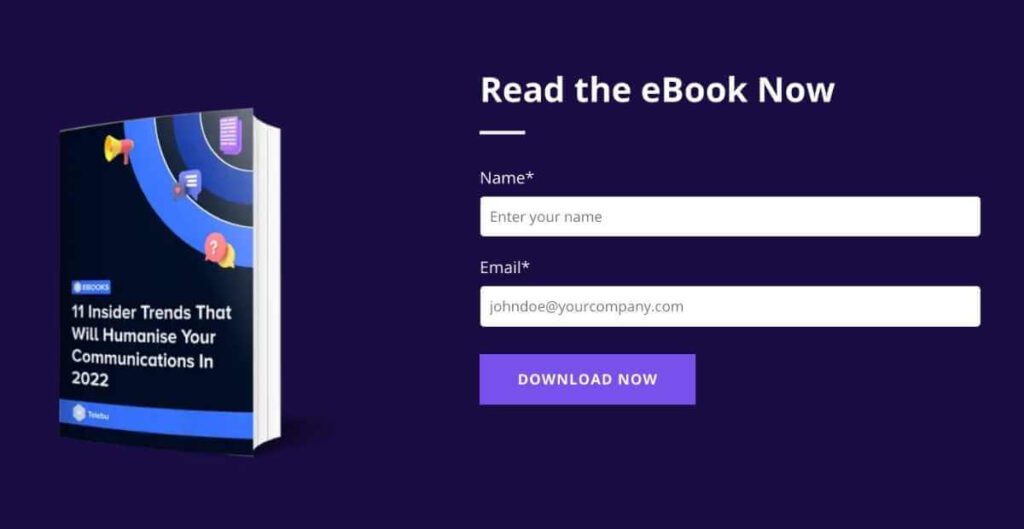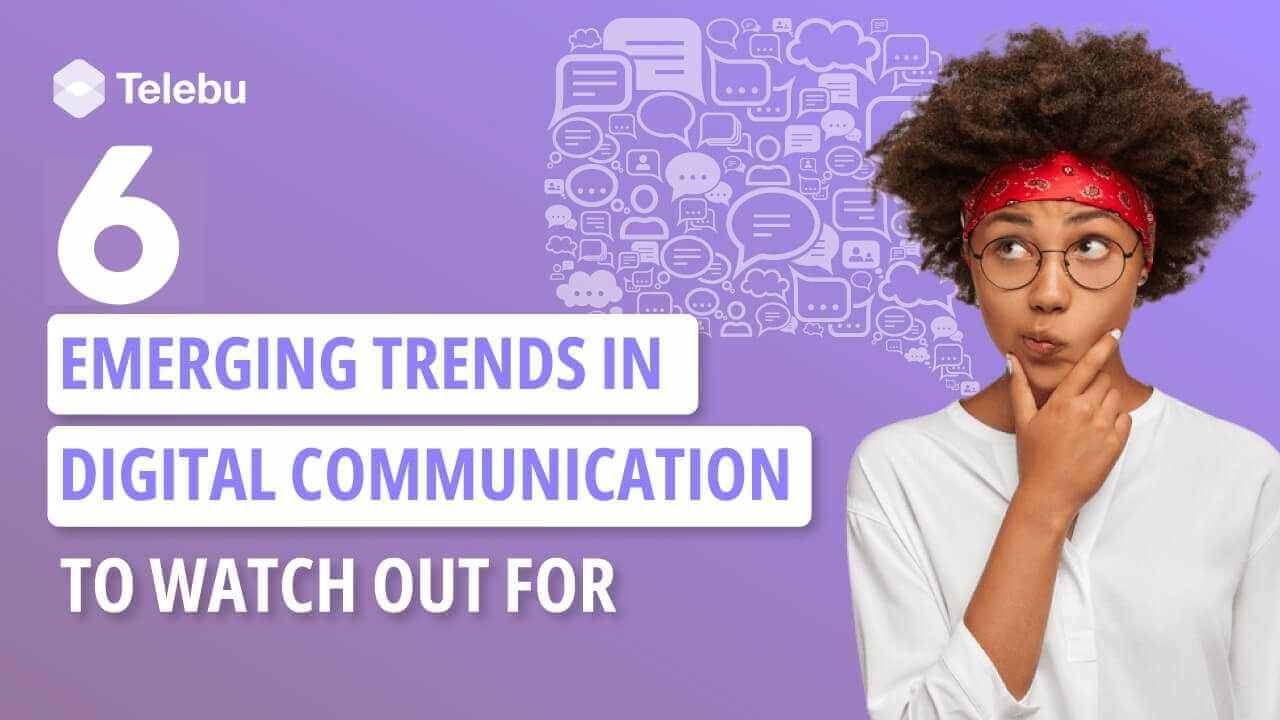Bootcut jeans are becoming trendy; skinny jeans are a thing of the past. Trends make the world go round. And trends in digital communication, even more so!
Why?
That’s because digital communication is the glue that holds our modern society together. And due to rapid technological changes, that landscape is expanding and changing faster than ever before.
Therefore, to keep up with the times, businesses like yours should stay updated on all the upcoming trends and updates.
As digital communication channels gain exponential prominence, businesses are now, more than ever before, able to improve their customer experience and adopt more effective business practices.
The question then is, what trends in digital communication might we expect this year or even next year? And what can businesses do to future-proof themselves?
We’ll take a deeper look at the answers to those questions below.
Watch out for these pivotal trends in digital communication
Here are the seven major trends in digital communication that we believe you need to watch out for to grow your business.
1. Interactive Messaging

Messaging services have proven very useful for businesses so far and will continue to be popular this year as well.
Customers fully welcome the use of messaging platforms since they personalise communication with businesses and brands they love. Moreover, most companies know that their clients and customers value richer and more substantial relationships.
And messaging platforms meet that need.
They make valuable conversations happen between enterprises and consumers.
Additionally, since more people continue to work from home or remotely, they naturally use these platforms more when communicating.
So, all in all, interactive and personalised messaging has not only made digital communication fun but highly effective. That’s why new software applications continue to break into the market to serve these needs.
An example is our very own SMSCountry – a powerful tool to power your foray into message-based solutions.
The platform results from two decades of building innovative SMS-based packages for customers. And with interactive messaging capabilities, Telebu Communications has demonstrated the importance of staying on top of trends in digital communication.
A welcome step for the industry. And if you jump in, a welcome step for your business.
2. AI-powered automation

Maintaining regular, open communication with your consumers at all times can be challenging. And unless you employ a dedicated team for the task, you’re bound to miss out on opportunities to communicate with current and potential customers.
Chatbot solutions, like TelebuPop, can easily take care of that. Standing tall as AI’s most prominent contribution to digital communications, they come in to handle customer queries and resolve recurring issues as soon as they arise— acting as your very own 24/7 customer support in the truest sense of the word.
So apart from offering virtual assistance after hours or when agents are occupied, chatbot solutions also come with smart templates, seamless transfer protocols to available agents, smart tagging, and proactive chats.
Additionally, setting them up is a low-cost and practical solution for automating specific day-to-day operations.
They allow you to concentrate your efforts on more valuable business facets as they take over routine customer communication.
Chatbots, therefore, allow you to:
- Monetise your social media pages.
- Answer customers’ queries around the clock.
- Boost your sales.
- Reach larger audiences.
- Increase and improve lead generation.
- Build brand awareness.
All thanks to advancements in artificial intelligence.
Predictive analytics, also powered by AI, help simplify consumer research and decision-making.
Further, integrating your CRM with its customer journey mapping and analytics can help you gain critical insights into customer interactions.
As you can see, AI-powered automation will continue to be an essential digital communication trend in the coming years.
3. The widespread adoption of hybrid work

The pandemic transformed business operations forever. It forced companies to rethink their workforce collaboration & communication structures.
Almost overnight, everyone had to go remote. A couple of years later, hybrid work has become the norm.
Businesses now have to see-saw between audio conferencing vs. video conferencing to stay in touch with not only their customers and clients but also their employees.
Due to that, platforms like grptalk, TelebuJoin, Zoom, Teams, and Google Meet have become familiar names in business circles.
The resulting challenge for organisations is how to make their newly remote and hybrid arrangements work.
It’s one thing to have the right tools in place and quite another to use them effectively.
Since all the enabling technologies for hybrid work can only improve moving forward, every virtual meeting and remote collaboration presents an opportunity for boosting productivity and ensuring user satisfaction.
4. Modern intranet software

Intranet software, commonly known as a digital workplace solution, centralises data and information, consequently making task delegation a breeze.
A modern intranet, on the other hand, is the newest iteration of the traditional intranet. It is designed to cater to how people work today—quickly, collaboratively, at all hours, and across different locations.
Organisations globally are implementing modern intranets in an attempt to help their staffers access the information, tools and resources they need for work from wherever they are and from whatever device they are using.
According to research, 85% of businesses have some form of intranet or employee hub.
This trend emerged as a natural progression spawned from what’s happened in the last decade.
The power of social media, widespread use of mobile devices, and remote work have all contributed to the emergence of the modern intranet – the kind that offers businesses the flexibility to scale as needed.
Additionally, all conversations, documents, tasks, and employee profiles remain in a central location. Such a handy feature for a team that’s adopted either a remote or hybrid model.
5. Hyper-personalisation

Hyper-personalisation is currently one of digital communications’ most “trendy” terms. And here’s the thing: it is a trend that isn’t going anywhere any time soon.
According to one study, 80% of US customers are more likely to buy items and services from companies with personalised customer support.
That means the personalisation of services is better for both customers and businesses.
Providing users with a highly tailored experience keeps them coming back. And that, in turn, moves the needle for more sales and the achievement of business goals.
As you may already know, hyper-personalisation is the secret ingredient to effective digital marketing strategies, be it social media ads, email marketing, push notifications, promotional SMSing, or specific retargeting ads.
“A total of 86% of marketing professionals consider the effectiveness of an AI-powered hyper-personalisation strategy to be changing for the better, with nearly one-third (31%) considering the change to be significant. So your investment in AI-powered hyper-personalization will make a positive change — you just need to get started!” – Source
Hyper-personalisation works and will continue to work because customers end up with highly relevant promotions and offers they are very likely to act on.
However, it’s worth noting that personalisation extends beyond just marketing efforts. It’s permeated all aspects of customer interactions, and companies are taking advantage to provide more valuable and memorable experiences.
6. The omnichannel approach

According to research, 90% of customers today demand and expect uniform interactions across multiple channels. They expect a consistent and seamless experience from businesses.
This customer need requires brands to employ an omnichannel approach. And a lot of them today are focused on making this happen. It is now a “must-have” rather than a “good-to-have.”
Using omnichannel platforms, instead of merely using multichannel capabilities, to connect with customers will remain one of the top trends in digital communication this year, specifically for customer support organisations and departments.
The omnichannel approach presents a very critical advantage.
Thanks to it, customers don’t have to repeat their concerns every time they contact your brand and, better still, every time they initiate contact via a different channel.
So this year, more and more businesses are expected to adopt omnichannel strategies and abandon siloed approaches.
You should also read:
- What is Audio Conferencing? All The Fundamentals You Need to Know
- Contact Center Software: Everything You Need to Know
- Instant Messaging Apps: Everything You Need To Know Right Now
- Best Video Conferencing App For Remote Work: An A-Z Guide
Capitalise on these trends in digital communication starting today
It’s essential to adjust your business’ direction according to new trends. If you don’t follow them closely, you will start to lag behind, and that’s not a favourable position for any business. Therefore, constantly staying updated is critical for anyone operating in today’s digitised world.
If your business struggles with either internal or external communication, we’ll be happy to help. Choose one of your products as a way of you pulling ahead of your competition, generating leads, acquiring new customers, or onboarded new clients. Talk to us today.
Before you go, here’s a resource that will bring a lot more clarity to the latest trends your business should watch out for.
It is a detailed synopsis in the form of an ebook to help you understand what the future holds in terms of digital communication and how your business can adapt and maximise its potential by leveraging those insights.





0 Comments